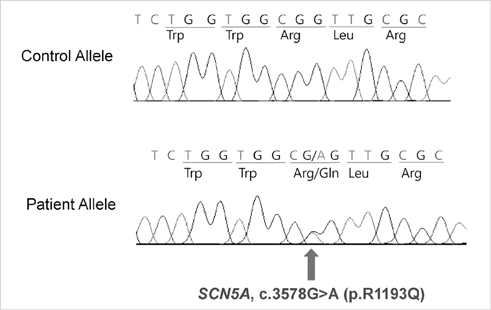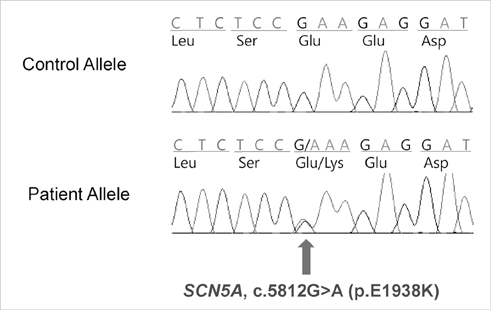J Korean Med Sci.
2013 Jul;28(7):1021-1026. 10.3346/jkms.2013.28.7.1021.
Genetic Mutation in Korean Patients of Sudden Cardiac Arrest as a Surrogating Marker of Idiopathic Ventricular Arrhythmia
- Affiliations
-
- 1Division of Cardiology, Department of Medicine, Samsung Medical Center, Sungkyunkwan University School of Medicine, Seoul, Korea. oykmd123@gmail.com
- 2Department of Laboratory Medicine and Genetics, Samsung Medical Center, Sungkyunkwan University School of Medicine, Seoul, Korea.
- 3Division of Pediatric Cardiology, Department of Pediatrics, Samsung Medical Center, Sungkyunkwan University School of Medicine, Seoul, Korea.
- KMID: 1777497
- DOI: http://doi.org/10.3346/jkms.2013.28.7.1021
Abstract
- Mutation or common intronic variants in cardiac ion channel genes have been suggested to be associated with sudden cardiac death caused by idiopathic ventricular tachyarrhythmia. This study aimed to find mutations in cardiac ion channel genes of Korean sudden cardiac arrest patients with structurally normal heart and to verify association between common genetic variation in cardiac ion channel and sudden cardiac arrest by idiopathic ventricular tachyarrhythmia in Koreans. Study participants were Korean survivors of sudden cardiac arrest caused by idiopathic ventricular tachycardia or fibrillation. All coding exons of the SCN5A, KCNQ1, and KCNH2 genes were analyzed by Sanger sequencing. Fifteen survivors of sudden cardiac arrest were included. Three male patients had mutations in SCN5A gene and none in KCNQ1 and KCNH2 genes. Intronic variant (rs2283222) in KCNQ1 gene showed significant association with sudden cardiac arrest (OR 4.05). Four male sudden cardiac arrest survivors had intronic variant (rs11720524) in SCN5A gene. None of female survivors of sudden cardiac arrest had SCN5A gene mutations despite similar frequencies of intronic variants between males and females in 55 normal controls. Common intronic variant in KCNQ1 gene is associated with sudden cardiac arrest caused by idiopathic ventricular tachyarrhythmia in Koreans.
MeSH Terms
-
Adolescent
Adult
Aged
Arrhythmias, Cardiac/genetics
*Death, Sudden, Cardiac
Ether-A-Go-Go Potassium Channels/genetics
Female
Genetic Markers
Genetic Predisposition to Disease
Genetic Variation
Heart/physiology
Heart Conduction System/abnormalities
Humans
KCNQ1 Potassium Channel/*genetics
Male
Middle Aged
NAV1.5 Voltage-Gated Sodium Channel/*genetics
Republic of Korea
Tachycardia, Ventricular/*genetics
Ventricular Fibrillation/*genetics
Young Adult
Ether-A-Go-Go Potassium Channels
Genetic Markers
KCNQ1 Potassium Channel
NAV1.5 Voltage-Gated Sodium Channel
Figure
Reference
-
1. Chopra N, Knollmann BC. Genetics of sudden cardiac death syndromes. Curr Opin Cardiol. 2011; 26:196–203.2. Tsai CF, Chen SA, Tai CT, Chiang CE, Ding YA, Chang MS. Idiopathic ventricular fibrillation: clinical, electrophysiologic characteristics and long-term outcomes. Int J Cardiol. 1998; 64:47–55.3. Napolitano C, Bloise R, Monteforte N, Priori SG. Sudden cardiac death and genetic ion channelopathies: long QT, Brugada, short QT, catecholaminergic polymorphic ventricular tachycardia, and idiopathic ventricular fibrillation. Circulation. 2012; 125:2027–2034.4. Albert CM, MacRae CA, Chasman DI, VanDenburgh M, Buring JE, Manson JE, Cook NR, Newton-Cheh C. Common variants in cardiac ion channel genes are associated with sudden cardiac death. Circ Arrhythm Electrophysiol. 2010; 3:222–229.5. Wolbrette D, Naccarelli G, Curtis A, Lehmann M, Kadish A. Gender differences in arrhythmias. Clin Cardiol. 2002; 25:49–56.6. Yarnoz MJ, Curtis AB. More reasons why men and women are not the same (gender differences in electrophysiology and arrhythmias). Am J Cardiol. 2008; 101:1291–1296.7. Freedman RA, Swerdlow CD, Soderholm-Difatte V, Mason JW. Clinical predictors of arrhythmia inducibility in survivors of cardiac arrest: importance of gender and prior myocardial infarction. J Am Coll Cardiol. 1988; 12:973–978.8. Wigginton JG, Pepe PE, Bedolla JP, DeTamble LA, Atkins JM. Sex-related differences in the presentation and outcome of out-of-hospital cardiopulmonary arrest: a multiyear, prospective, population-based study. Crit Care Med. 2002; 30:S131–S136.9. Albert CM, McGovern BA, Newell JB, Ruskin JN. Sex differences in cardiac arrest survivors. Circulation. 1996; 93:1170–1176.10. James AF, Choisy SC, Hancox JC. Recent advances in understanding sex differences in cardiac repolarization. Prog Biophys Mol Biol. 2007; 94:265–319.11. Di Diego JM, Cordeiro JM, Goodrow RJ, Fish JM, Zygmunt AC, Pérez GJ, Scornik FS, Antzelevitch C. Ionic and cellular basis for the predominance of the Brugada syndrome phenotype in males. Circulation. 2002; 106:2004–2011.12. Moric-Janiszewska E, Głogowska-Ligus J, Paul-Samojedny M, Węglarz L, Markiewicz-Łoskot G, Szydłowski L. Age-and sex-dependent mRNA expression of KCNQ1 and HERG in patients with long QT syndrome type 1 and 2. Arch Med Sci. 2011; 7:941–947.13. Lu HR, Remeysen P, Somers K, Saels A, De Clerck F. Female gender is a risk factor for drug-induced long QT and cardiac arrhythmias in an in vivo rabbit model. J Cardiovasc Electrophysiol. 2001; 12:538–545.14. Lujan HL, Kramer VJ, DiCarlo SE. Sex influences the susceptibility to reperfusion-induced sustained ventricular tachycardia and beta-adrenergic receptor blockade in conscious rats. Am J Physiol Heart Circ Physiol. 2007; 293:H2799–H2808.
- Full Text Links
- Actions
-
Cited
- CITED
-
- Close
- Share
- Similar articles
-
- Management of Aborted Sudden Cardiac Arrest with J Wave Syndrome
- Idiopathic Polymorphic Ventricular Tachycardia: a “Benign Disease†with a Touch of Bad Luck?
- Medullary Infarction Presenting as Sudden Cardiac Arrest: Report of Two Cases and Review of the Literature
- Early Repolarization Syndrome with Idiopathic Ventricular Fibrillation
- Two women presenting aborted sudden cardiac arrest as the first event of mitral valve disease





